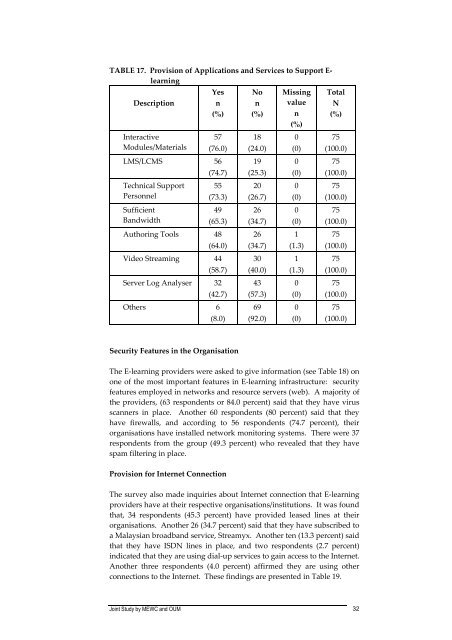e-learning readiness - Asia Pacific Region - Open University Malaysia
e-learning readiness - Asia Pacific Region - Open University Malaysia
e-learning readiness - Asia Pacific Region - Open University Malaysia
- No tags were found...
Create successful ePaper yourself
Turn your PDF publications into a flip-book with our unique Google optimized e-Paper software.
TABLE 17. Provision of Applications and Services to Support E-<strong>learning</strong>DescriptionYesn(%)InteractiveModules/Materials57(76.0)LMS/LCMS 56(74.7)Technical Support 55Personnel(73.3)Sufficient49Bandwidth(65.3)Authoring Tools 48(64.0)Video Streaming 44(58.7)Server Log Analyser 32(42.7)Others 6(8.0)Non(%)18(24.0)19(25.3)20(26.7)26(34.7)26(34.7)30(40.0)43(57.3)69(92.0)Missingvaluen(%)0(0)0(0)0(0)0(0)1(1.3)1(1.3)0(0)0(0)TotalN(%)75(100.0)75(100.0)75(100.0)75(100.0)75(100.0)75(100.0)75(100.0)75(100.0)Security Features in the OrganisationThe E-<strong>learning</strong> providers were asked to give information (see Table 18) onone of the most important features in E-<strong>learning</strong> infrastructure: securityfeatures employed in networks and resource servers (web). A majority ofthe providers, (63 respondents or 84.0 percent) said that they have virusscanners in place. Another 60 respondents (80 percent) said that theyhave firewalls, and according to 56 respondents (74.7 percent), theirorganisations have installed network monitoring systems. There were 37respondents from the group (49.3 percent) who revealed that they havespam filtering in place.Provision for Internet ConnectionThe survey also made inquiries about Internet connection that E-<strong>learning</strong>providers have at their respective organisations/institutions. It was foundthat, 34 respondents (45.3 percent) have provided leased lines at theirorganisations. Another 26 (34.7 percent) said that they have subscribed toa <strong>Malaysia</strong>n broadband service, Streamyx. Another ten (13.3 percent) saidthat they have ISDN lines in place, and two respondents (2.7 percent)indicated that they are using dial-up services to gain access to the Internet.Another three respondents (4.0 percent) affirmed they are using otherconnections to the Internet. These findings are presented in Table 19.Joint Study by MEWC and OUM 32
















